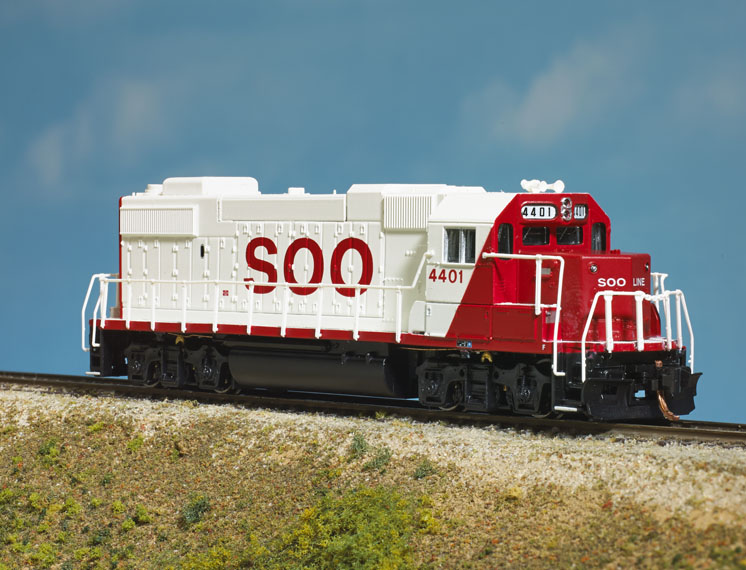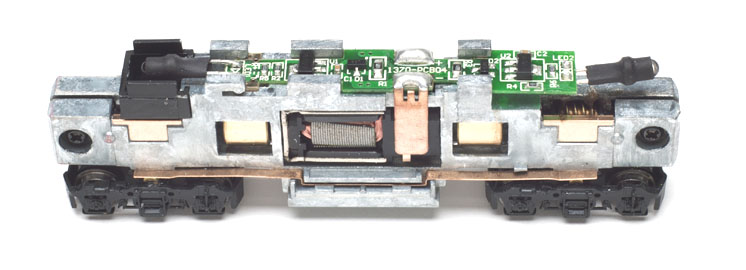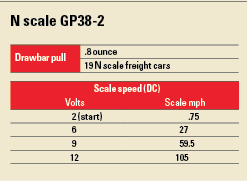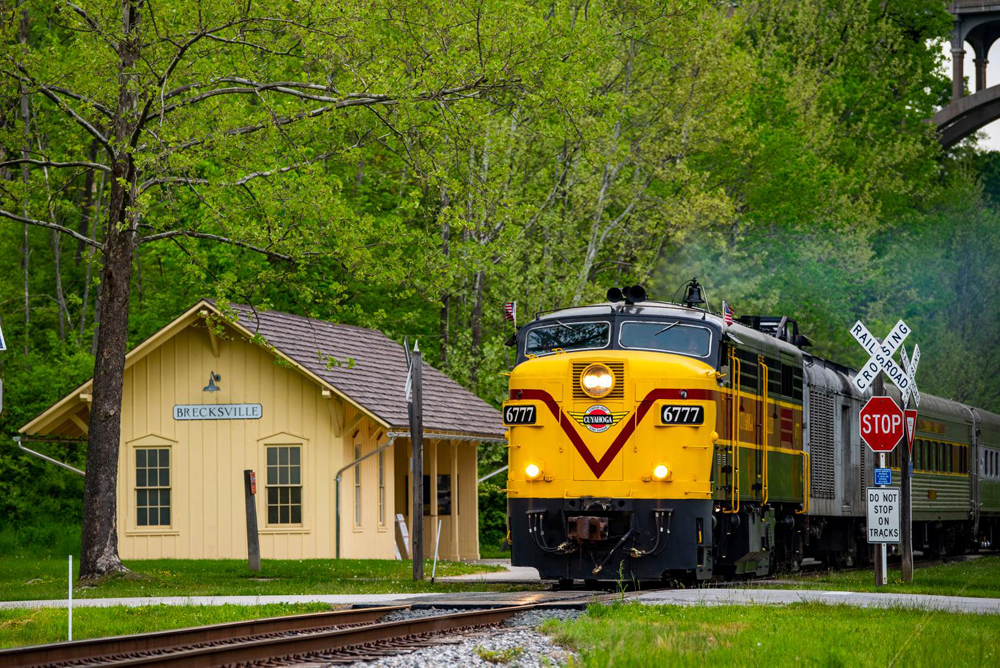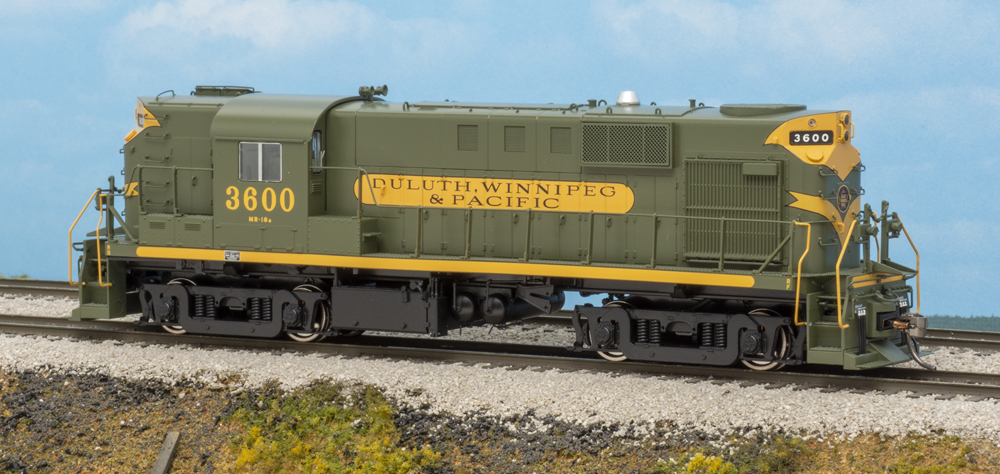The prototype. The GP38-2 was a four-axle flagship for the “Dash 2” product line of General Motors’ Electro-Motive Division. Like its predecessor GP38, the Dash 2 version featured a 2,000-hp EMD 645 diesel. However, the GP38-2 featured many additional internal upgrades, including an AC/DC electrical system with a modular design that allowed for much easier and quicker maintenance.
The GP38-2 is a versatile locomotive that has been used in yard, hump, helper, and commuter service, in addition to its typical freight chores. The locomotive’s versatility and reliability made it one of EMD’s best-selling locomotives. More than 2,200 GP38-2 diesels were sold between 1972 and 1986. Many are still in service today.
The model. The Walthers GP38-2 matches the dimensions of prototype drawings in the 1974 Car and Locomotive Cyclopedia of American Practice (Simmons-Boardman). Because N scale couplers are oversize, the length of the model from coupler pulling face to pulling face is 2 scale feet too long.
Modelers and railfans often refer to minor changes that occurred during locomotive production as “phases.” The Walthers model is of a Phase II GP38-2, and as such correctly models spotting features such as an 88″ short hood and corrugated side air intakes. Earlier GP38-2s had 81″ short hoods and mesh air intakes.
Most of the details, including all grab irons, are molded on the plastic body shell. The molded detail is well defined and properly placed, according to prototype photos. The handrails and stanchions are made of flexible acetal plastic. The material is rigid enough to keep the handrails straight and flexible enough to resist breaking.
The model also features prototype-specific details, such as a snowplow. The three-chime horn in the center of the cab roof and the winterization hatch over the rear radiator fan are also correct for the Soo prototype. According to prototype photos, some rooftop details are missing on the model, including the prototype’s “firecracker” antenna and rotary beacon.
All the cab windows feature clear glazing. The front windshields have molded windshield wipers.
The paint scheme on the model matches the prototype no. 4401. Red lettering was applied to Soo Line GP38-2 diesels numbered 790 to 799 in the late 1970s. These units were renumbered 4400 to 4409.
The model’s lettering is clearly printed and opaque. I appreciated details such as the EMD builder’s plates printed on the side sills below the battery box door, as well as the water level sight glass on the engineer’s side of the long hood. This latter detail is a spotting feature of the prototype GP38-2.
The mechanism. I removed the press-fit body shell by inserting the tip of my hobby knife between the body shell and frame and then carefully spreading one side of the shell to disengage it from the frame. I then repeated this action on the other side. Using a gentle rocking motion I easily lifted off the shell.
The split die-cast metal frame encloses the motor and flywheels. Worm gears transfer power from the motor to gearboxes on each truck. All axles are powered.
Metal contact strips run under the frame to the trucks. Contacts also run on the inside of the truck sideframes. All the wheels pick up electricity.
The main printed-circuit board has built in light-emitting diodes (LEDs) on each end and clips to the frame. Contact strips under this board also pick up power via the frame, and help keep the LED illumination constant.
Since the model has a split frame and an isolated motor, it’s truly DCC ready. The clip-on PC board is easy to remove when converting the model to DCC. Board-replacement decoders are available from Digitrax (part no. DN163LOA) and Train Control Systems (L1D4).
I measured the motor’s stall current at 100mA, which is well under the 1A rating of the decoders listed above.
Performance. The model’s mechanism is extremely smooth and quiet. At 2V the locomotive crept along at less than 1 scale mph. The model accelerated to a top speed of 105 scale mph at 12V. The prototype could be geared for maximum speeds of 71, 77, or 83 mph.
The GP38-2 easily handled switching cars back and forth through no. 6 turnouts. The locomotive also negotiated a 93⁄4″ radius curve on the branch line of our N scale Red Oak project layout without any difficulty.
The model’s heavy frame and all-wheel drive help it achieve a respectable .8 ounce drawbar pull, which is equivalent to 19 scale freight cars on straight and level track.
A reliable mechanism and DCC-friendly design make this model a smooth operator. Combine this performance with prototypical detailing, and the Walthers GP38-2 is a standout addition to an N scale roster.
Manufacturer
Wm. K. Walthers Inc.
5601 W. Florist Ave.
Milwaukee, WI 53218
www.walthers.com
Era: 1977 to present (as detailed)
Road names (two numbers per scheme): Soo Line (red lettering), BNSF Ry., Canadian National, Conrail, CSX, and Union Pacific. Undecorated version also available.
Features
▪▪All-wheel drive and electrical pickup
▪▪Die-cast metal split frame
▪▪Five-pole skew-wound motor with brass flywheel
▪▪Light-emitting diode (LED) headlights
▪▪Micro-Trains plastic knuckle couplers at the correct height
▪▪RP-25 contour metal wheels in gauge
▪▪Weight: 2.7 ounces





